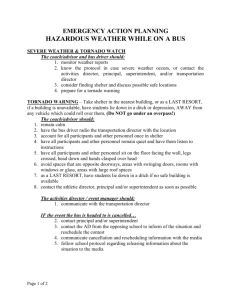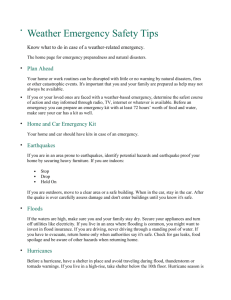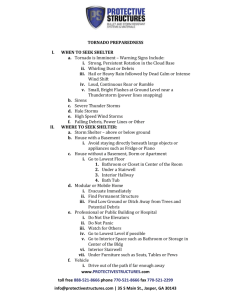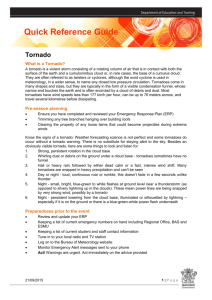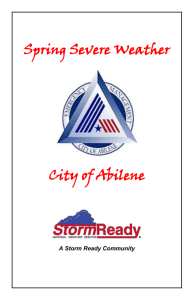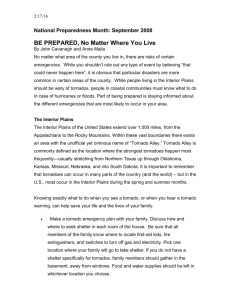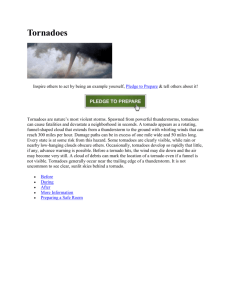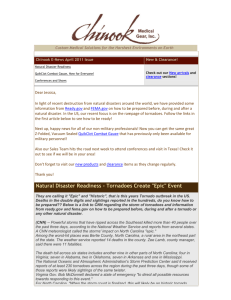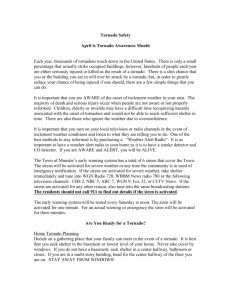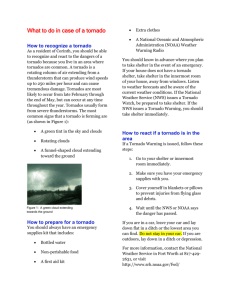File - Survival SOS
advertisement
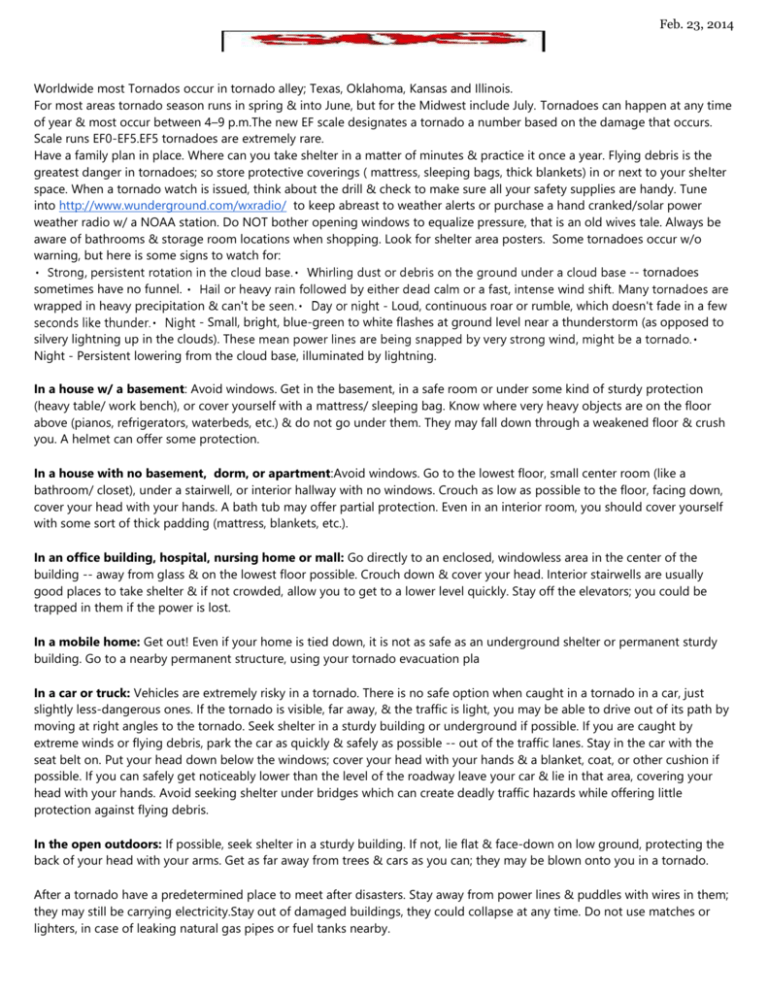
Feb. 23, 2014 Worldwide most Tornados occur in tornado alley; Texas, Oklahoma, Kansas and Illinois. For most areas tornado season runs in spring & into June, but for the Midwest include July. Tornadoes can happen at any time of year & most occur between 4–9 p.m.The new EF scale designates a tornado a number based on the damage that occurs. Scale runs EF0-EF5.EF5 tornadoes are extremely rare. Have a family plan in place. Where can you take shelter in a matter of minutes & practice it once a year. Flying debris is the greatest danger in tornadoes; so store protective coverings ( mattress, sleeping bags, thick blankets) in or next to your shelter space. When a tornado watch is issued, think about the drill & check to make sure all your safety supplies are handy. Tune into http://www.wunderground.com/wxradio/ to keep abreast to weather alerts or purchase a hand cranked/solar power weather radio w/ a NOAA station. Do NOT bother opening windows to equalize pressure, that is an old wives tale. Always be aware of bathrooms & storage room locations when shopping. Look for shelter area posters. Some tornadoes occur w/o warning, but here is some signs to watch for: -- tornadoes sometimes have no funnel. wrapped in heavy precipitation & ca - Loud, continuous roar or rumble, which doesn't fade in a few - Small, bright, blue-green to white flashes at ground level near a thunderstorm (as opposed to silvery lightning up in the clouds). Th Night - Persistent lowering from the cloud base, illuminated by lightning. In a house w/ a basement: Avoid windows. Get in the basement, in a safe room or under some kind of sturdy protection (heavy table/ work bench), or cover yourself with a mattress/ sleeping bag. Know where very heavy objects are on the floor above (pianos, refrigerators, waterbeds, etc.) & do not go under them. They may fall down through a weakened floor & crush you. A helmet can offer some protection. In a house with no basement, dorm, or apartment:Avoid windows. Go to the lowest floor, small center room (like a bathroom/ closet), under a stairwell, or interior hallway with no windows. Crouch as low as possible to the floor, facing down, cover your head with your hands. A bath tub may offer partial protection. Even in an interior room, you should cover yourself with some sort of thick padding (mattress, blankets, etc.). In an office building, hospital, nursing home or mall: Go directly to an enclosed, windowless area in the center of the building -- away from glass & on the lowest floor possible. Crouch down & cover your head. Interior stairwells are usually good places to take shelter & if not crowded, allow you to get to a lower level quickly. Stay off the elevators; you could be trapped in them if the power is lost. In a mobile home: Get out! Even if your home is tied down, it is not as safe as an underground shelter or permanent sturdy building. Go to a nearby permanent structure, using your tornado evacuation pla In a car or truck: Vehicles are extremely risky in a tornado. There is no safe option when caught in a tornado in a car, just slightly less-dangerous ones. If the tornado is visible, far away, & the traffic is light, you may be able to drive out of its path by moving at right angles to the tornado. Seek shelter in a sturdy building or underground if possible. If you are caught by extreme winds or flying debris, park the car as quickly & safely as possible -- out of the traffic lanes. Stay in the car with the seat belt on. Put your head down below the windows; cover your head with your hands & a blanket, coat, or other cushion if possible. If you can safely get noticeably lower than the level of the roadway leave your car & lie in that area, covering your head with your hands. Avoid seeking shelter under bridges which can create deadly traffic hazards while offering little protection against flying debris. In the open outdoors: If possible, seek shelter in a sturdy building. If not, lie flat & face-down on low ground, protecting the back of your head with your arms. Get as far away from trees & cars as you can; they may be blown onto you in a tornado. After a tornado have a predetermined place to meet after disasters. Stay away from power lines & puddles with wires in them; they may still be carrying electricity.Stay out of damaged buildings, they could collapse at any time. Do not use matches or lighters, in case of leaking natural gas pipes or fuel tanks nearby.


